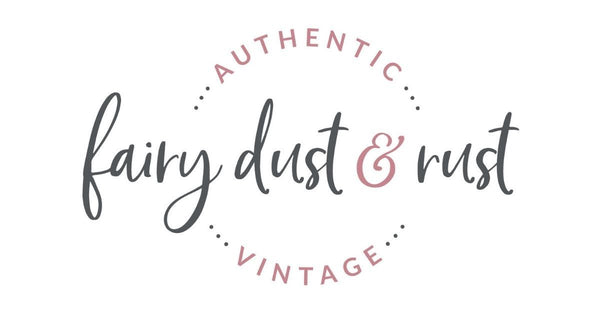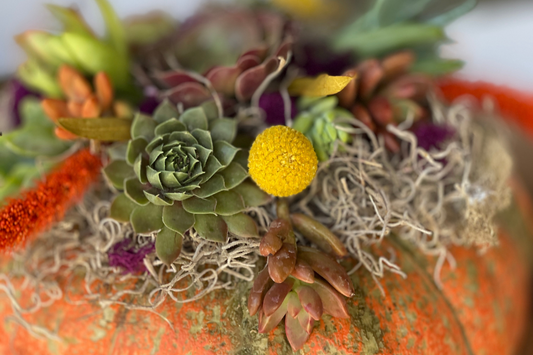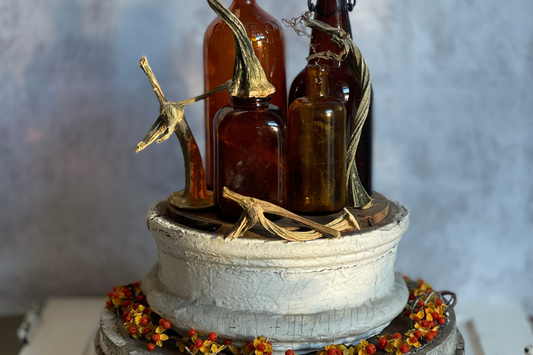Make your own Fabulous Fall Wreath.
Supplies:
Two packages of Corn Husks for Tamales. You can find these at your grocery store.
- One Box of Straight Pins -Flat Top at least 1.5 Inches long.
- Floral Pins
- Metal finger thimble
- 1 12” Hay Wreath Form
- Large Bowl of Water or Sink with Stopper
- Strainer
- Glue Gun
- Plastic Table Covering
- Paper Towel or Absorbent Towel
- Hair Dryer
- Sunshine
Getting Started:
Soak the husks in a large bowl of warm water for 10 minutes. This will soften your husks so they will be pliable to work with. When you take the husks out of the water, tear them into strips, approximately 1.5-2 inches wide. They tear easily with the grain of the husk. I like to have variations in the size of my strips, so some are thinner and some are wider. Set the strips in a strainer or drying rack. Let the husks drip dry a little bit (15- 20 minutes), so they are still wet, but not soaking wet.

Meanwhile, set up your work area and cover the table with the large plastic table cover.
Lay out your wreath on top of the plastic. Bring the strainer full of husk strips to your work area. I like to put a dish towel under the strainer to absorb water. You may want to wear an apron.
Assembling the Wreath:
Take 2-3 husks and begin pinning them to the surface hay wreath form. It's a good idea to use the thimble as you push in those pins, it will save your finger!
You will be pinning the widest part of the husk to the wreath. Pointy ends will be at the outer edges of the wreath. Working in a clockwise direction, tuck and lift the husks you previously pinned and pin 2-3 more husks. We are going to be hiding the pins this way. Don’t worry if your pins begin to show through, we will cover those at the end of the project.

Continue to pin the husks around the wreath form, and try to create some variations in the amount of husks and spread them apart as you go. I like mine in a circular starburst pattern. Once you have completed the front part of the wreath, fill in all along the sides using the same method. I alternate between the straight pins and floral pins to be sure I have adequately secured the husks to the wreath form.
Flip the wreath over to work on the back. It will be droopy, but just take some care here and be gentle. Cover the back side of the exposed hay wreath with the husks. You don’t have to be as precise or work in a pattern like you did on the front side. I use some of the larger strips to cover the backside. We want the backside to be flatter so it will hang nicely on a door.
While it’s upside down, begin to pin husks against the inside center portion of the wreath form. Use single husks and pin flat against the center part of the wreath. This step will also help to blend in the front edges.
Flip back over and pin in more husks to the open spaces. Keep in mind, it's not necessary to have every space covered, we will do that once it’s dry!
Now, head outside and cue the sunshine! Lay it flat on its back outside in the sunny location to dry for several hours. I suggest laying it on something that will allow airflow to the underside too. Drying in the sun will shrink the husks and cause some beautiful twists and curls to naturally occur.
At this time, take your extra husk strips and set out in the sun to dry as well. We will use these dried strips to fill in gaps and hide pins once the wreath is completely dry.
Once it’s mostly dry, I like to hang it off a peg or corner of a chair to ensure airflow and drying to all sides.
Once the wreath is completely dry, it's time to fill in the visible gaps and spaces with the extra dried husks. Use hot glue to cover the exposed pins, gaps and tuck in some husks to build it up and create more fluff and dimension.
There you have it! Hang wreath on a door, over the mantel or anywhere you choose. The wreath will last all season long, and with proper care and storage can last for years to come.
The extra dried husks are great to use around your home as fall decor. Tuck them in vases and nooks. Scatter on your dining table, use as bowl filler, or layer some in-between your fruit display.







